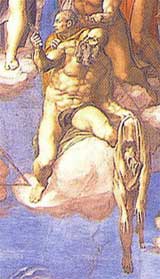Michelangelo Biography: Rome
In 1534 Michelangelo left Florence and never returned. His proud and independent spirit could not tolerate Alessandro de' Medici's tyranny. How much he loved liberty is proven by his unfinished, but vigorous and striking bust of Brutus.
Again Michelangelo was to be forced to the making of one of his greatest works against his will, and against his violent desire to carry out the long-deferred contract for the tomb of Julius. He had come back to Rome to carry out at length this thwarted purpose.

Michelangelo: Self Portrait
as Saint Bartholomew
The Last Judgment (detail)
One month later, October, 1534, Alexander Farnese became Pope under the name of Paul III. One of the Pope's first wishes was to have Michelangelo in his service. And against the artist's prayer to allow him to carry out his engagements of honor, the Pope exclaimed: "I have entertained this wish for thirty years, and now that I am Pope, shall I not realize it?"
And he saw that Michelangelo begins the work on the Last Judgment, the fresco on the altar wall of the Sistine Chapel, which was commissioned by Clement VII. shortly before his death. Again Michelangelo thought of flight from Rome as an escape and made his preparations; but remembering how impossible it had been to escape from the previous demands of former Popes, wherever he fled, he yielded to the honors conferred upon him, which made him chief architect, sculptor, and painter with a salary for life. He finished the work on the Last Judgment in 1541.
Immediately after, Pope Paul III set him to work on the side walls of the Capella Paolina (Pauline Chapel), just completed by Antonio da Sangallo. Michelangelo, facing the fatiguing task of fresco painting over a large surface, began the works in 1542 and finished in 1549. The two frescoes representing the Conversion of St. Paul and the Crucifixion of St. Peter are his last pictorial works.
Called upon to take up architectural work, in 1546 Michelangelo was appointed architect of Saint Peter's Basilica in the Vatican. He stood in the way of many others coveting the position or the profits. Michelangelo devoted himself through pure obedience to the task of completing Saint Peter's, refusing all compensation during the remainder of his life, offering his unpaid services both to his master and to the service of religion.
Michelangelo's last years
Little else occupied his last years. We know this last portion of the great man's career by the records of the tedious work at Saint Peter's, and what remains of his poems, which in their rude and unfinished form tell us how the fire never burnt out as long as any place remained to hold it. But he had retired within himself and the ideas of religion filled the demands of his desires. He had been disappointed in many things: his ideal of civic life had disappeared from the world; he had not accomplished most of the work his heart was bent on; he viewed with austerity his own excessive enjoyment of beauty; he had met few other lives that could equally move along with his own. Perhaps he was conscious of his enormous importance, but he was modest beyond all other men and devoid of what is called ambition. This was the moderate end for which he had created the marvels of art which belong to his name.
Michelangelo died on February 18, 1564. His death marked for all Italy the close of the great period. There was a contest between Rome and Florence as to which city should keep Michelangelo's body.
Florence, however, kept Michelangelo, and gave him a princely funeral, and the usual unpoetic tomb that serves for princes. Though both cities, and most men of the time, misstated and misapprehended many of the reasons of Michelangelo's greatness, they were not so far different from most of us.
It has taken many centuries and many minds to build a sufficient intellectual appreciation of the man who perhaps was the greatest of all artists.
Michelangelo's life:
Michelangelo: BiographyMichelangelo and Lorenzo de' Medici
Michelangelo in Rome and Florence